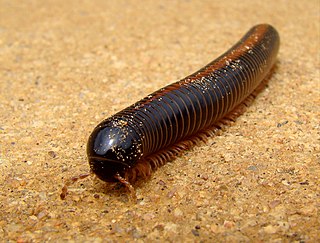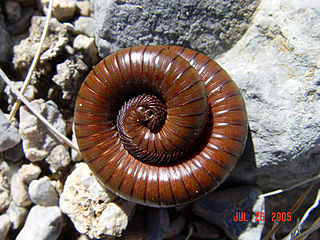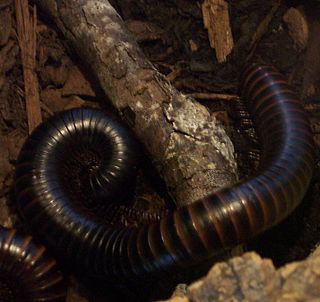 W
WSpirostreptida is an order of long, cylindrical millipedes. There are approximately 1000 described species, making Spirostreptida the second largest order of millipedes after Polydesmida.
 W
WArchispirostreptus is a genus of giant African millipedes in family Spirostreptidae, containing 26 species:
 W
WArchispirostreptus gigas, known as the giant African millipede or shongololo, is the largest extant species of millipede, growing up to 33.5 centimetres (13.2 in) in length, 67 millimetres (2.6 in) in circumference. It has approximately 256 legs, although the number of legs changes with each molting so it can vary according to each individual.
 W
WCambala is a genus of millipedes in the family Cambalidae. There are about 18 described species in Cambala.
 W
WCambala minor is a species of millipede in the family Cambalidae. It is found in North America.
 W
WCambalidae is a family of millipedes in the order Spirostreptida. There are at least 20 genera and 80 described species in Cambalidae.
 W
WDoratogonus is a genus of millipedes in family Spirostreptidae. They are relatively large, at 80–200 millimetres (3–8 in) long, relatively common, and distributed across Southern Africa. Many of the species are listed on the IUCN Red List due to habitat destruction.
 W
WIulomorphidae is a family of millipedes in the order Spirostreptida. There are about 11 genera and more than 60 described species in Iulomorphidae.
 W
WOrthoporus is a genus of spirostreptid millipedes, containing around 80 species, distributed from the southern United States to Brazil and Argentina.
 W
WOrthoporus ornatus is a North American species of millipede in the family Spirostreptidae that can be found in the U.S. states of Arizona, New Mexico and Texas, and as far south as the Mexican state of San Luis Potosí. They became very popular in the pet trade and many were exported to Western Europe. Brian Van Der Kieft and Max Prins were the first breeders of this species in Europe. Individuals on average are 4 inches (10 cm) in length, but can either be as small as 3 inches (76 mm), or exceed up to 6 inches (150 mm) in length. They are dark brownish coloured, but can sometimes be yellow. In fact, in every state the species look different. The antennae are located near the organs of Tömösváry. The species feed on both living and dead organic material. The species prefer sunshine, but can be seen on summer rainy days as well. A disturbed Orthoporus ornatus may curl into a coil and release a toxic substance that is located on all sides of its body. The species can live more than ten years. The species feed on shrubs of Ephedra, which grows in Jornada del Muerto, and on Salsola that grows in Albuquerque.
 W
WPhyllogonostreptus nigrolabiatus is a common species of millipede found in India, and Sri Lanka.
 W
WThe Seychelles giant millipede, is a species of millipede endemic to Seychelles.
 W
WSpirostreptidae is a family of millipedes in the order Spirostreptida. It contains around 100 genera distributed in North and South America, the eastern Mediterranean, continental Africa, Madagascar, and Seychelles. It contains the following genera:
 W
WSpirostreptus is a genus of giant millipedes of the family Spirostreptidae. It contains the following species:
 W
WThyropygus is a genus of millipedes in the family Harpagophoridae, widely distributed throughout Southeast Asia. With over 50 named species, it is the most-species rich genus of Harpagophoridae in Southeast Asia. Over 30 species occur in Thailand.